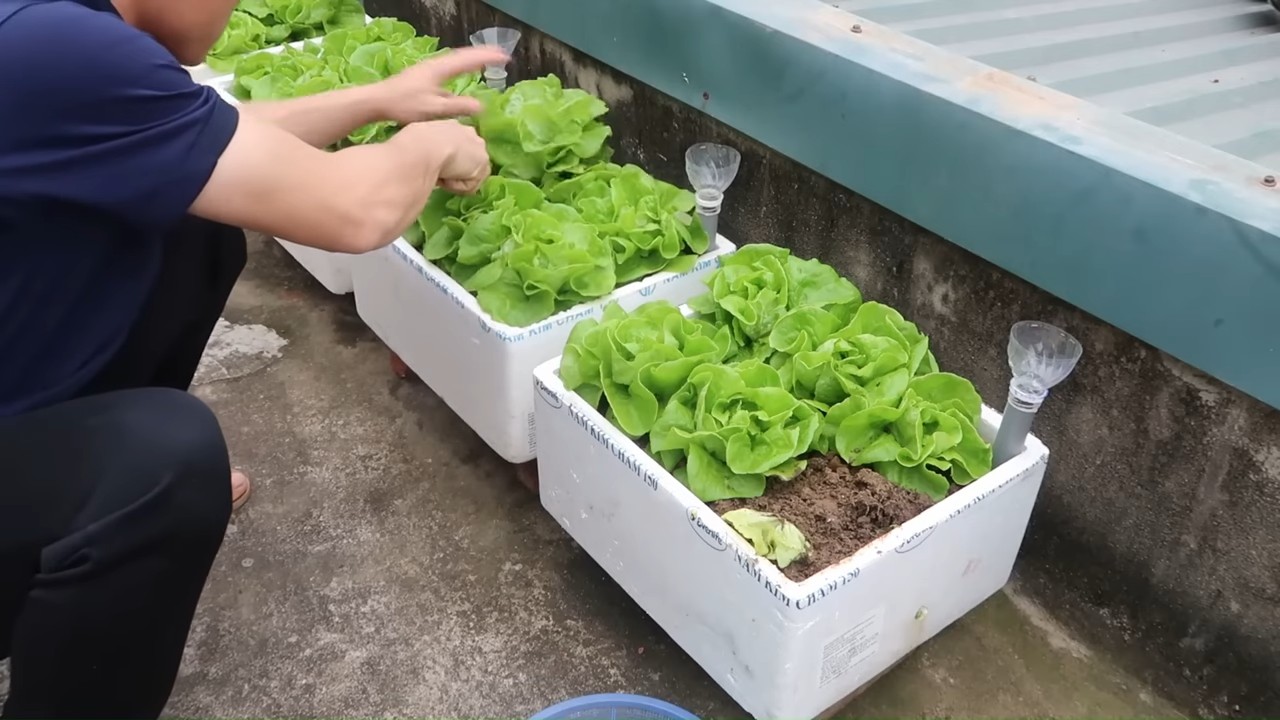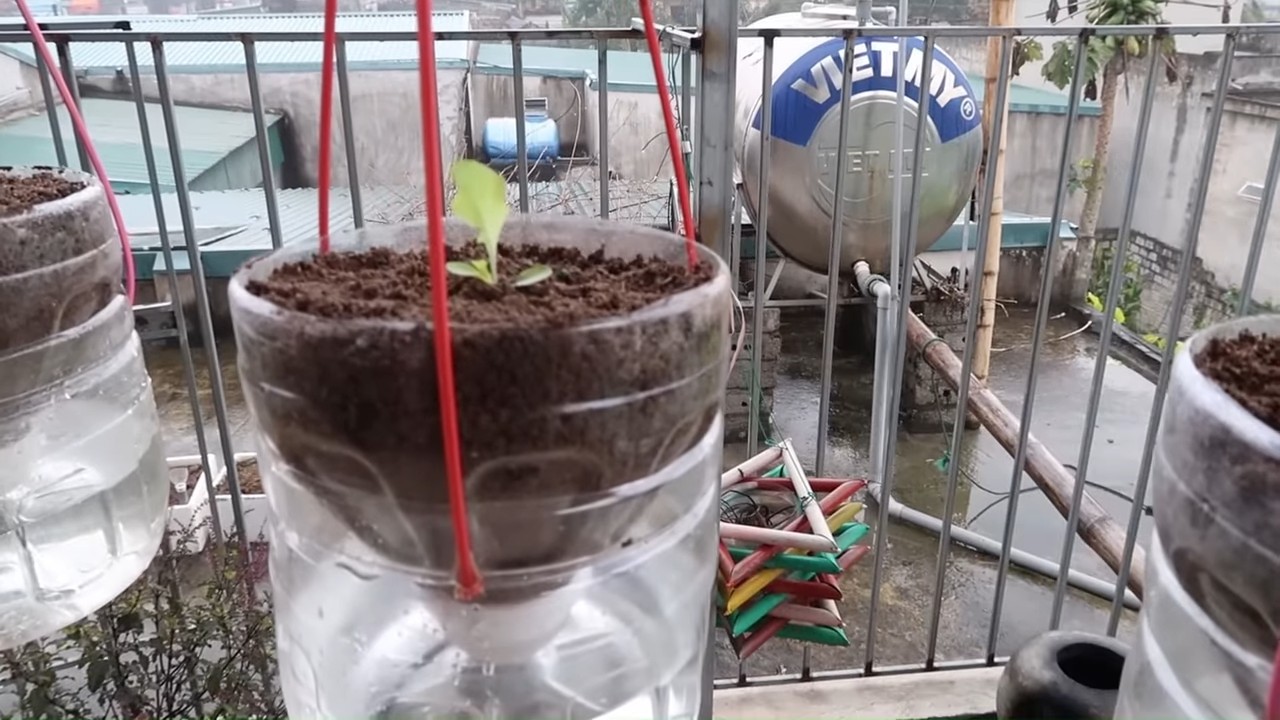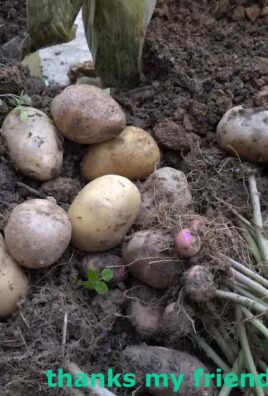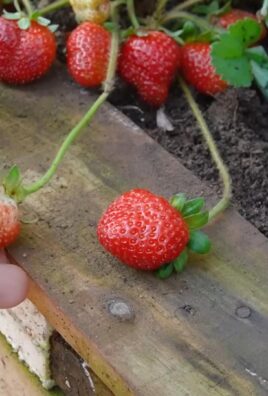Hanging lettuce garden, no watering? Sounds like a dream, right? Well, get ready to wake up to reality because I’m about to share some incredible DIY tricks that will revolutionize your home gardening experience, especially if you’re craving fresh, crisp lettuce without the daily watering chore!
For centuries, humans have cultivated lettuce, tracing its origins back to ancient Egypt where it was initially grown for its seeds and oil. Over time, it evolved into the leafy green we know and love, becoming a staple in salads and sandwiches worldwide. But let’s be honest, keeping lettuce consistently watered, especially in warmer climates, can be a real pain. That’s where this DIY magic comes in!
Imagine this: lush, vibrant lettuce cascading from hanging baskets, thriving with minimal effort on your part. No more wilting leaves, no more forgotten watering schedules, just fresh, delicious lettuce at your fingertips. This isn’t just about convenience; it’s about creating a sustainable and beautiful garden that fits seamlessly into your busy lifestyle. A hanging lettuce garden is the perfect solution for small spaces, balconies, or anyone looking to add a touch of green to their home without the hassle of traditional gardening. So, let’s dive into these simple yet effective DIY tricks and hacks that will transform your gardening game forever!

DIY Self-Watering Hanging Lettuce Garden: No More Daily Watering!
Hey there, fellow gardening enthusiasts! Are you tired of constantly watering your lettuce, only to find it wilting in the summer heat? Or maybe you just don’t have the space for a traditional garden? Well, I’ve got the perfect solution for you: a self-watering hanging lettuce garden! This project is surprisingly easy, budget-friendly, and will keep your lettuce happy and hydrated with minimal effort on your part. Trust me, once you try this, you’ll never go back to regular gardening.
What You’ll Need:
Before we dive in, let’s gather all the necessary materials. This will make the process smoother and prevent any frustrating mid-project trips to the hardware store.
* Two Plastic Buckets (Different Sizes): You’ll need one larger bucket (around 5 gallons) and one smaller bucket that can fit comfortably inside the larger one with some space around the sides and at the bottom. Think of it like a pot-in-pot system.
* Drill with Various Drill Bits: We’ll be drilling holes for drainage, wicking, and hanging.
* Wicking Material: This is crucial for the self-watering aspect. I recommend using strips of old t-shirts (cotton works best), felt, or even mop head strands. Make sure it’s a material that can effectively draw water upwards.
* Potting Mix: Choose a high-quality potting mix that’s well-draining. Avoid using garden soil, as it can compact and hinder drainage.
* Lettuce Seedlings or Seeds: Pick your favorite lettuce varieties! I personally love a mix of romaine, butter lettuce, and red leaf lettuce for a colorful and flavorful salad.
* Hanging Chain or Rope: This will be used to hang your beautiful lettuce garden. Make sure it’s strong enough to support the weight of the buckets, soil, and water.
* Landscape Fabric or Burlap: This will help prevent soil from falling through the drainage holes.
* Measuring Tape or Ruler: For accurate measurements when drilling holes.
* Scissors or Utility Knife: For cutting the wicking material and landscape fabric.
* Gloves: To keep your hands clean while working with soil.
* Water: Of course, we’ll need water to fill the reservoir!
Preparing the Buckets: The Foundation of Our Garden
This is where we transform ordinary buckets into a functional self-watering system. Take your time and be precise with your measurements and drilling.
1. Drilling Drainage Holes in the Outer Bucket: Grab your larger bucket. We need to create drainage holes to prevent the soil from becoming waterlogged. Using a drill bit that’s about 1/4 inch in diameter, drill several holes (around 6-8) in the bottom of the bucket. Space them evenly apart. These holes will allow excess water to escape.
2. Drilling Hanging Holes in the Outer Bucket: Now, we need to create holes for hanging the bucket. Measure down about an inch or two from the top rim of the larger bucket. Mark four equidistant points around the bucket. These will be where we drill the holes for the hanging chain or rope. Use a drill bit that’s slightly larger than the diameter of your chain or rope. Drill the holes carefully, making sure they’re clean and smooth.
3. Preparing the Inner Bucket: This bucket will hold the soil and lettuce. We need to create holes for the wicking material to draw water up from the reservoir.
4. Drilling Wicking Holes in the Inner Bucket: Take your smaller bucket and drill several holes (around 4-6) in the bottom. These holes should be large enough to accommodate the wicking material. I usually use a 3/8 inch drill bit for this. Space the holes evenly apart.
5. Drilling Small Drainage Holes in the Inner Bucket (Optional): This step is optional, but I recommend it for added drainage. Drill a few small (1/8 inch) drainage holes in the sides of the inner bucket, near the bottom. This will help prevent the soil from becoming too saturated.
Assembling the Self-Watering System: Bringing It All Together
Now comes the fun part – putting all the pieces together to create our self-watering system!
1. Lining the Outer Bucket with Landscape Fabric: Cut a piece of landscape fabric or burlap that’s large enough to line the bottom of the larger bucket. This will prevent soil from falling through the drainage holes. Place the fabric in the bottom of the bucket, making sure it covers all the holes.
2. Inserting the Wicking Material: Cut your wicking material into strips that are long enough to reach from the bottom of the inner bucket to the bottom of the outer bucket. Thread one end of each strip through the wicking holes in the bottom of the inner bucket. Make sure the strips are securely in place. You want a good amount of the wick hanging out of the bottom of the inner bucket.
3. Placing the Inner Bucket Inside the Outer Bucket: Carefully place the inner bucket inside the larger bucket. The wicking material should be hanging down into the space between the two buckets. Make sure the inner bucket sits securely on the bottom of the outer bucket, leaving a space for the water reservoir.
4. Testing the Wicking Action: Before adding soil, it’s a good idea to test the wicking action. Fill the outer bucket with water until it reaches the bottom of the inner bucket. Observe the wicking material. You should see the water gradually being drawn upwards into the inner bucket. If the wicking isn’t working properly, adjust the length or placement of the wicking material.
Planting Your Lettuce: The Heart of the Garden
This is where we bring our lettuce garden to life! Choose your favorite lettuce varieties and get ready to plant.
1. Filling the Inner Bucket with Potting Mix: Fill the inner bucket with high-quality potting mix, leaving about an inch or two of space at the top. Gently pat down the soil to remove any air pockets.
2. Planting Lettuce Seedlings or Seeds: If you’re using seedlings, carefully remove them from their containers and plant them in the potting mix, spacing them evenly apart. If you’re using seeds, sow them according to the package instructions.
3. Watering the Soil Initially: After planting, water the soil thoroughly. This will help the seedlings establish their roots and ensure that the wicking material is properly saturated.
4. Adding Water to the Reservoir: Fill the outer bucket with water until it reaches the bottom of the inner bucket. This will create the water reservoir that will keep your lettuce hydrated.
Hanging Your Lettuce Garden: The Final Touch
Now it’s time to hang your beautiful lettuce garden and enjoy the fruits (or rather, vegetables) of your labor!
1. Attaching the Hanging Chain or Rope: Attach the hanging chain or rope to the holes you drilled in the larger bucket. Make sure the chain or rope is securely fastened.
2. Choosing a Location: Choose a location that receives at least 6 hours of sunlight per day. A sunny balcony, patio, or even a sturdy tree branch would be ideal.
3. Hanging the Garden: Carefully hang your lettuce garden in the chosen location. Make sure it’s hanging securely and that it’s not exposed to strong winds.
Maintaining Your Self-Watering Lettuce Garden: Keeping It Thriving
The beauty of this system is its low maintenance, but a little care goes a long way.
1. Monitoring the Water Level: Check the water level in the outer bucket regularly, especially during hot weather. Refill the reservoir as needed. You’ll likely need to refill it less often than you would with a traditional garden.
2. Fertilizing Your Lettuce: Lettuce benefits from regular fertilization. Use a liquid fertilizer diluted to half strength and apply it every few weeks.
3. Harvesting Your Lettuce: Harvest your lettuce as needed. You can either harvest the entire head or simply pick off the outer leaves. This will encourage the plant to produce more leaves.
4. Pest Control: Keep an eye out for pests, such as aphids or slugs. If you notice any pests, treat them with an appropriate organic pesticide.
5. Rotating Your Lettuce: After a few months, your lettuce may start to bolt (go to seed). When this happens, it’s time to replace the plants. You can either start new seedlings or purchase new ones.
Troubleshooting: Addressing Common Issues
Even with the best planning, sometimes things don’t go exactly as expected. Here are a few common issues and how to address them:
* Lettuce Wilting: If your lettuce is wilting, it could be due to several factors. Check the water level in the reservoir. If it’s low, refill it. Also, make sure the wicking material is properly saturated. If the wicking isn’t working, try adjusting the length or placement of the wicks. In extreme heat

Conclusion
So, there you have it! Creating your own self-watering hanging lettuce garden is not just a fun project; it’s a game-changer for anyone who loves fresh, homegrown greens but struggles with space or time. Imagine stepping outside your door and snipping off the perfect amount of crisp, flavorful lettuce for your salad, sandwich, or wrap, all without the daily chore of watering. This DIY trick truly revolutionizes the way you can enjoy fresh produce.
The beauty of this system lies in its simplicity and efficiency. By utilizing readily available materials and a clever self-watering design, you’re creating a sustainable and low-maintenance source of delicious lettuce. It’s a fantastic way to reduce your grocery bills, minimize your environmental impact, and add a touch of green beauty to your balcony, patio, or even a sunny indoor space.
But don’t stop at just one type of lettuce! Experiment with different varieties to create a colorful and flavorful mix. Consider adding other leafy greens like spinach, arugula, or even herbs like parsley and chives to your hanging garden. You can also adjust the size of your containers to accommodate larger plants or create a tiered system for a more visually appealing and productive garden. Think about adding companion plants like marigolds to deter pests naturally.
This project is also incredibly adaptable to different climates and growing conditions. If you live in a particularly hot or sunny area, consider using a shade cloth to protect your lettuce from scorching. In cooler climates, you might want to bring your hanging garden indoors during the winter months or use a grow light to extend the growing season.
The possibilities are truly endless, and the rewards are well worth the effort. Not only will you have a constant supply of fresh, organic lettuce at your fingertips, but you’ll also experience the satisfaction of creating something beautiful and functional with your own two hands.
We wholeheartedly encourage you to give this DIY self-watering hanging lettuce garden a try. It’s a project that’s accessible to gardeners of all skill levels, and the results are simply amazing. Once you’ve built your own hanging lettuce oasis, we’d love to hear about your experience! Share your photos, tips, and variations in the comments below. Let’s inspire each other to grow more of our own food and create a more sustainable and delicious world, one hanging lettuce garden at a time. We are confident that this **hanging lettuce garden** will be a great addition to your home.
Frequently Asked Questions (FAQ)
What type of lettuce grows best in a hanging garden?
Loose-leaf lettuce varieties are generally the best choice for hanging gardens. They are compact, easy to harvest, and produce a continuous supply of leaves. Some popular options include:
* Black Seeded Simpson
* Red Sails
* Oak Leaf
* Buttercrunch
* Romaine (dwarf varieties)
Avoid head lettuce varieties like iceberg, as they require more space and may not thrive as well in a hanging container.
How often do I need to refill the water reservoir?
The frequency of refilling the water reservoir will depend on several factors, including the size of the container, the type of lettuce you’re growing, the weather conditions, and the maturity of the plants. In general, you should check the water level every few days and refill it when it gets low. During hot, dry weather, you may need to refill it more frequently. A good rule of thumb is to check the soil moisture near the top of the container. If it feels dry to the touch, it’s time to refill the reservoir.
What type of soil should I use?
Use a high-quality potting mix that is specifically formulated for containers. Avoid using garden soil, as it can be too heavy and compacted for a hanging garden. A good potting mix will provide adequate drainage and aeration, which are essential for healthy lettuce growth. You can also amend the potting mix with compost or other organic matter to improve its fertility and water-holding capacity.
How much sunlight does my hanging lettuce garden need?
Lettuce prefers partial shade, especially during the hottest part of the day. Aim for at least 4-6 hours of sunlight per day. If you live in a particularly hot climate, consider placing your hanging garden in a location that receives morning sun and afternoon shade. You can also use a shade cloth to protect your lettuce from scorching.
How do I harvest the lettuce?
Harvesting lettuce from a hanging garden is easy. Simply snip off the outer leaves as needed, leaving the inner leaves to continue growing. This method, known as “cut and come again,” allows you to harvest lettuce continuously over a long period. Avoid harvesting more than one-third of the plant at a time, as this can stress the plant and reduce its yield.
How do I prevent pests and diseases?
To prevent pests and diseases in your hanging lettuce garden, start with healthy plants and use a high-quality potting mix. Regularly inspect your plants for signs of pests or diseases, such as aphids, slugs, or powdery mildew. If you find any pests, you can try removing them by hand or using an insecticidal soap. To prevent diseases, avoid overwatering and ensure good air circulation around the plants. You can also use a fungicide if necessary. Companion planting with marigolds can also help deter pests.
Can I grow other vegetables in a hanging garden?
Yes, you can grow other vegetables in a hanging garden, but it’s important to choose varieties that are well-suited for containers. Some good options include:
* Spinach
* Arugula
* Herbs (parsley, chives, basil)
* Strawberries
* Cherry tomatoes
* Peppers (dwarf varieties)
Consider the size and growth habits of the plants when choosing what to grow in your hanging garden.
How do I fertilize my hanging lettuce garden?
Lettuce is a relatively light feeder, but it will benefit from regular fertilization. Use a balanced liquid fertilizer diluted to half strength every 2-3 weeks. You can also amend the potting mix with compost or other organic matter to provide a slow-release source of nutrients. Avoid over-fertilizing, as this can lead to leggy growth and reduced flavor.
What if my lettuce starts to bolt (go to seed)?
Bolting is a common problem with lettuce, especially during hot weather. When lettuce bolts, it becomes bitter and unpalatable. To prevent bolting, choose heat-tolerant varieties, provide shade during the hottest part of the day, and keep the soil consistently moist. If your lettuce starts to bolt, you can try harvesting the remaining leaves and planting new seeds.
How long will my hanging lettuce garden last?
With proper care, your hanging lettuce garden can last for several months. However, lettuce is a cool-season crop, so it will eventually bolt and stop producing leaves. When this happens, you can remove the old plants and start a new crop. You can also extend the growing season by bringing your hanging garden indoors during the winter months or using a grow light.




Leave a Comment